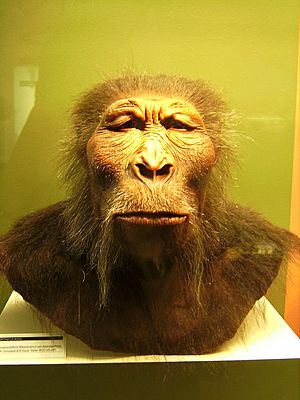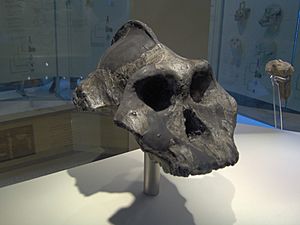Paranthropus facts for kids
Quick facts for kids ParanthropusTemporal range: Pleistocene
|
|
|---|---|
 |
|
| Skull of Paranthropus boisei | |
| Scientific classification | |
| Kingdom: | |
| Phylum: | |
| Class: | |
| Order: | |
| Family: | |
| Subfamily: | |
| Tribe: | |
| Subtribe: | |
| Genus: |
Paranthropus
Broom, 1938
|
| Species | |
|
†Paranthropus aethiopicus |
|
Paranthropus was a group of ancient human relatives that are now extinct. They were known for their strong, sturdy bodies. Scientists believe they probably came from an earlier group called Australopithecus.
Contents
What Was Paranthropus Like?
All Paranthropus species walked on two legs, just like us! They lived at the same time as early humans from the Homo group, like Homo ergaster and Homo erectus.
Paranthropus first appeared around 2.7 million years ago. Most species had a brain that was about 40 percent the size of a modern human brain. They were usually about 1.3 to 1.4 meters (4.26 to 4.59 feet) tall and were quite muscular. Scientists think Paranthropus lived in wooded areas, unlike Australopithecus which preferred grasslands.
How Paranthropus Looked Different
Australopithecus and Paranthropus looked very different, but mostly in their skulls. The rest of their skeletons were quite similar. This suggests their skull differences were an adaptation to different foods.
Paranthropus had a much stronger skull and teeth. They often had gorilla-like bony ridges on top of their skulls, called sagittal crests. These ridges were where huge chewing muscles attached, helping them to chew tough foods.
What Paranthropus Ate
Paranthropus did not behave in the same way as early Homo species. They ate a diet of very tough plant material. This included leaves, thin branches, grass, and roots. They might have also eaten insect grubs.
Unlike early humans, Paranthropus relied on steady environmental conditions in tropical forests. They were not as flexible in their behavior. Members of the Homo group, like Homo habilis, had larger brains. This allowed them to eat a much wider variety of foods.
Where Paranthropus Lived
Paranthropus species like P. boisei and P. aethiopicus followed their own evolutionary path. This path was different from early humans. Paranthropus shared the Earth with some early Homo species. These included H. habilis, H. ergaster, and possibly even H. erectus.
How Smart Was Paranthropus?
Paranthropus species had smaller braincases than Homo. However, their brains were still much larger than those of Australopithecus.
Paranthropus fossils are sometimes found near stone tools in Africa. But scientists debate if Paranthropus actually made and used these tools. Most believe that early Homo species were the tool makers. It is also very likely that most Paranthropus species did not have language. They probably did not control fire either, even though their remains are found with evidence of fire at a site called Swartkrans in South Africa.
Discovering Paranthropus

A part of a skull and lower jaw of Paranthropus robustus was found in 1938. A schoolboy discovered it about 70 kilometers southwest of Pretoria in South Africa. Robert Broom from the Transvaal Museum described it as a new type of ancient human relative. This site is at least 1.95 million years old.
Paranthropus boisei was discovered by Mary Leakey in July 1959. She found it at the Olduvai Gorge site in Tanzania. Mary was working alone because her husband, Louis Leakey, was sick. When she told him the news, Louis quickly felt much better!
Louis first thought it was very similar to humans, calling it Titanohomo mirabilis. He and Mary lovingly called it "Dear Boy." The fossil was found with Oldowan tools and animal bones.
The discovery was announced in the scientific journal Nature in August 1959. Louis named the fossil Zinjanthropus boisei. "Zinj" was an old Arabic word for the East African coast. "Boisei" was named after Charles Boise, who helped fund the Leakeys' research. Louis believed this fossil was different enough from Australopithecus to be a new genus.
Raymond Dart, another famous scientist, was still alive. He was very happy for Louis when he saw the "Zinj" fossil. Louis had thought about using Broom's Paranthropus name. But he decided against it because he believed "Zinj" was an ancestor of humans, and Paranthropus was not. He focused on the larger size of "Zinj's" canine teeth.
The debate over the name lasted for many years. It even caused some disagreement between Louis and another scientist, Wilfrid Le Gros Clark. Clark believed the fossil should be called Paranthropus. However, this discovery made the Leakeys famous around the world. They had no trouble finding money for their research after that. The "Zinj" naming question eventually became part of the larger debate about Australopithecus versus Paranthropus.
Images for kids
See also
 In Spanish: Paranthropus para niños
In Spanish: Paranthropus para niños










